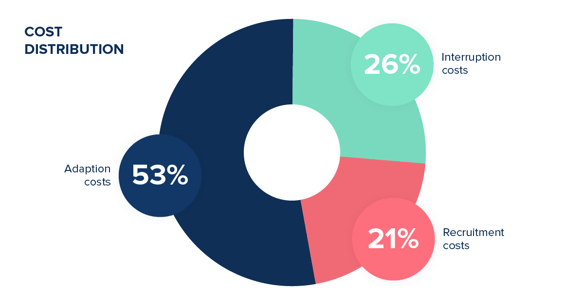A bad hire costs $80.000 according to Randstad (2015).
... but potentially the cost can be higher if you look closely at the numbers from a study made by Muehlemann & Leiser (2018). It shows that especially training of the new hire is what is causing the costs to increase.
New hire training costs takes up more than 79 percent of the total costs when hiring a new employee, and thus it is not the initial recruitment costs that carry the most weight.
During the new hire training, ressources needs to used in order to make the new employee effective, and that also applies when the employees have to familiarize themselves with new workflows, but also when existing employees have to help during the process.
Structuring the onboarding can help bring down the costs, and in the section below you can learn more about the specific categories of costs. When you realize it, it is actually not that hard to calculate the value of onboarding.
Categories of Costs:
-
Recruitment costs: Search for the candidate/selection, screening, interviews, and evaluation.
-
Adaption costs: Training new employees, lack of productivity.
-
Interruption costs: When existing employees have to help new employees and end up moving further away from their own tasks

Kilde: HR Guiden online
There is a big variation in costs - depending on the profession you wish to employ.
Onboarding Decreases Costs
Structured onboarding can decrease the cost of hiring a new employee. That minimizes the time-to-performance by up to 60 percent. Simultaneously, effective onboarding optimizes employee engagement by more than 20 percent, and when the employee is engaged, there is 87 percent less risk that the employee leaves the organization within 12 months.
Another benefit is that an onboarding process creates retention, and will prevent you from having to spend more money on starting a new recruitment process. This is very important to remember, as 25 percent of all new hires quit within the first 12 months.
Create a Structured Onboarding Program
Onboarding covers both practical, personal, and relational factors, and it is the process where a new employee goes from being an outsider to becoming an insider.
It is not enough to just put some nice flowers on the new hire's desk and let them start their tasks straight away. Onboarding is more than that.
Beyond the administrative tasks that need to be in place when you have a new hire, it is also important that the new employee experience becoming a part of the social work environment and community. Furthermore, you might have several other areas you want to introduce a new hire to as well, like compliance.
A buddy program is a good tool to introduce a new hire to the organizational culture and community. The new hire will be assigned a professional buddy, who will help out with specific work tasks, but also a social buddy from another department, who will take the new hire out on coffee-walks, and introduce the new hire to the wider organization and its culture - and become a part of the organization.
Digital onboarding is another tool that can be used to create a successful onboarding program. In digital onboarding, you can present the organization's history, mission, and goal in a fun and engaging learning universe, which could be based on gamification, for instance.
That way the new hire will feel like a part of the organization faster, but also be able to understand how their skills can contribute to help the organization achieve its goal.

/blog_learningbankers_at_work.jpg?width=580&name=blog_learningbankers_at_work.jpg)
